The mobile app market is tough these days. What really stands out is the app user experience, the way a mobile app design & development approach can smooth out business processes, build lasting engagement, and, honestly, make people want to keep coming back.
Consumers expect apps to be intuitive and effective. Every tap should add real value, not just tick a box. You can sense the change. Experience-led development has gone from buzzword to strategy. And here’s what matters: this approach digs deep into user experience design, how actual people work, what their routines look like, and what really helps.
This requires productivity, removing friction, and understanding how a service already works. This is where the future is headed, and that’s the breakdown. Discover how mobile app design and development can transform your business processes.
Experience-Led Development Defined
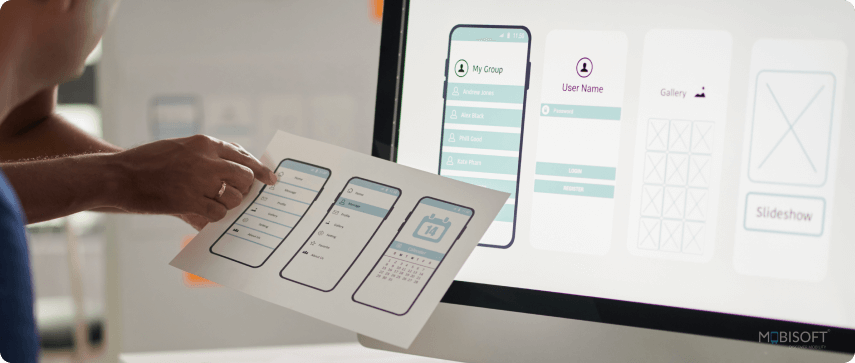
Experience-led development goes beyond just surface-level polish. It means designing solutions that fit the actual problem environment. This requires extensive planning of the whole mobile UX design journey. Beginning from the mobile app onboarding and transaction steps to profile and feedback channels. Every interface-related decision should be made keeping the holistic app experience in mind.
It means more than flashing features or complex mobile app design elements. Too often, business leaders mistake experience for just visual appeal or technical bells and whistles. But real user-centred app design covers every interaction. It means cutting down on decision fatigue, trimming unnecessary steps, and making sure critical tasks are smooth and secure. Whether you’re bringing on new users or enabling complex system integrations, the platform should help users with their tasks.
Learn how thoughtful user experience design elevates every interaction in your app.
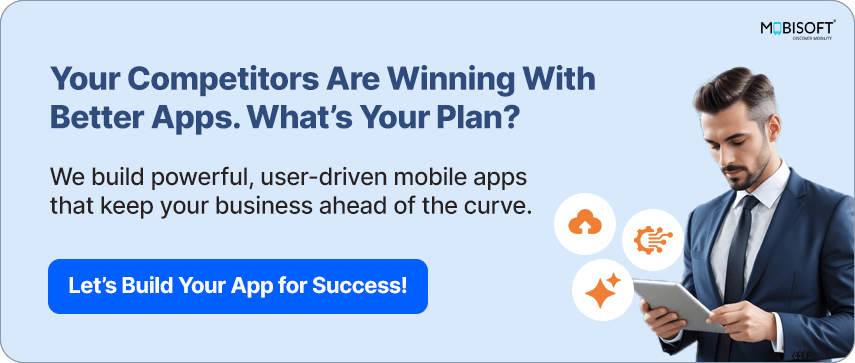
Impact of Workflow-Centric Apps (2025)
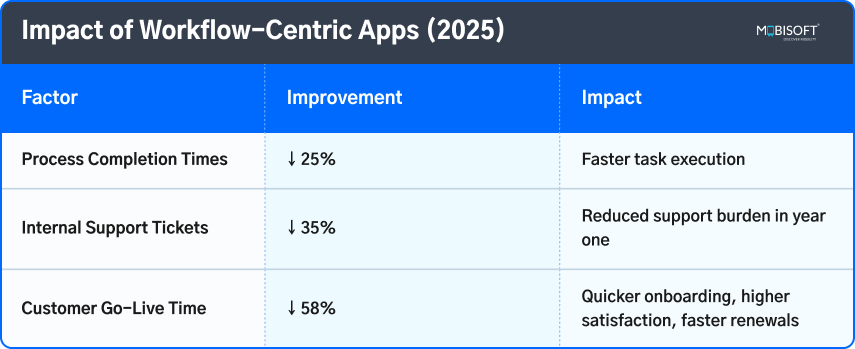
Design-Led vs Experience-Led
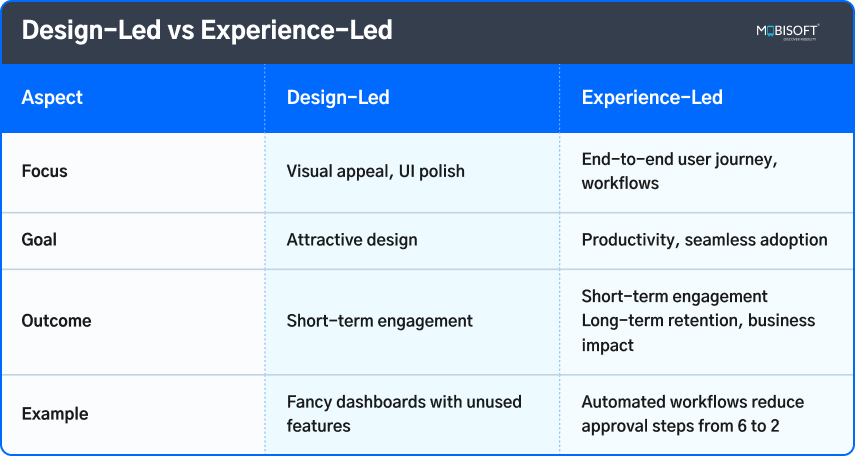
Seamless Collaboration
Usually, apps get designed first, then developed. Contrarily, Experience-led development needs ongoing alignment with every stakeholder. That means constant feedback, UX design research, and market insights. Operations, client success, and security teams all have to be part of the conversation to tackle real pain points with each update.
For many firms, cross-functional sprints are now the norm. These sessions lean heavily on mobile app engagement analytics, which lets teams quickly pivot to features that drive adoption or make mobile UX design smoother. According to SurveySparrows, email surveys are at 15-25%, and in-app/web pop-ups are reaching 20-30% response rates. This shows active engagement in feedback collection efforts.
Source: Survey Response Rate Benchmarks: Industry Standards vs. Reality in 2025
Why Mobile Apps Require Experience-Led Development
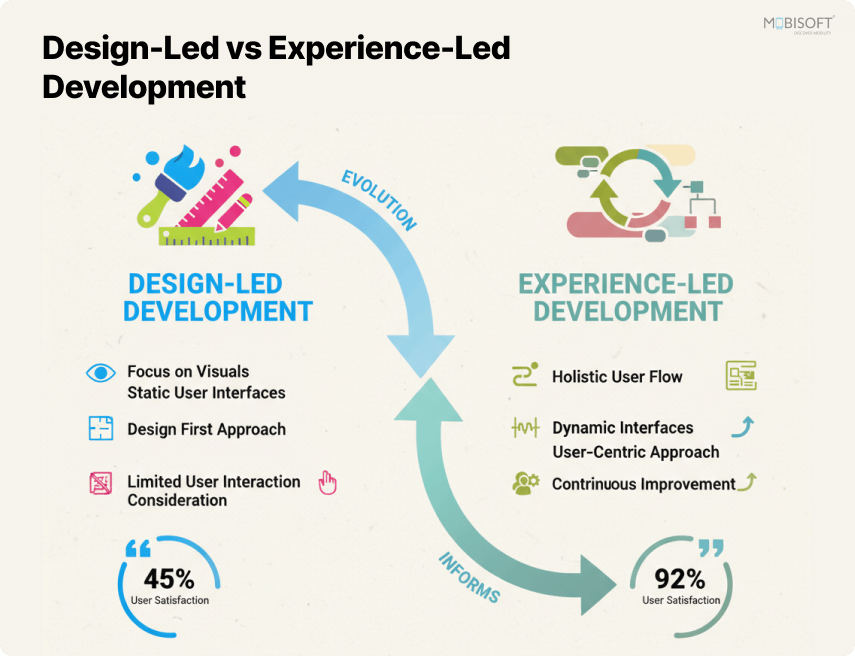
Mobile always feels personal, and it carries a heavy operational weight. The people using these apps have zero patience for anything confusing or inefficient. GoDaddy surveyed 1,000 U.S. consumers asking about their mobile app user experience. Only 21% agreed that small businesses provide a convenient online experience, despite 91% of small business owners believing they do.
Source: Customer Expectations vs Retailer’s Reality
User Abandonment Risks
App abandonment creates one of the biggest challenges in mobile app engagement. Losing a user lowers engagement, disrupts workflows, delays decisions, and causes real business losses. Stats by Croplink show 48% users abandon carts due to unexpected costs such as payment fees. While 85.2% don’t complete the process due to friction, including slow checkout. That’s why businesses must understand why professionals drop apps.
Source: Cart Abandonment Statistics 2025
Why 56% of Mobile Apps Are Uninstalled Within 7 Days

Experience-led development addresses this by automating routine steps, reducing decision fatigue, and providing instant outcomes that align with how teams actually work.
Enterprise User Expectations in 2025
Every app user wants things to be simple and clear. In 2024, Global app downloads reached about 218 billion downloads, reports GourmetAds. With a significant portion tied to professional or productivity tools, it shows no sign of slowing down in 2025. People use apps for different reasons, but with the sole purpose of making their tasks easier. Friendly navigation and simplistic mobile UX design have hence become a priority for developers.
Explore the essential mobile app UX design best practices to improve usability and engagement.
For B2B apps, leaders expect actionable insights at a glance, faster onboarding for teams, and interfaces that cut down repetitive clicks. With time-pressed executives driving adoption, apps that fail to reduce friction risk abandonment. Clarity and speed are core features in B2B apps, rather than just some “nice-to-haves”.
Source: Number of App Downloads in 2025
Device Constraints, Business Demands
Designing for mobile means facing some tough limits. Screens are small, and space is precious.
That forces apps to focus on what really matters, not crowd users with extras. Experience-led product development means avoiding feature overload and focusing on smart mobile design thinking that matches user goals and business KPIs. See how experience-led product development can streamline your mobile solutions.
As of April 2025, there are over 2.25 billion 5G connections worldwide, with adoption accelerating at a rate four times faster than 4G during its corresponding growth phase. This allows for inventory checkers, single-tap order confirmations for distributors, and a smooth experience for the customers.
Source: The State of 5G in 2025
Why is Device Fragmentation a Bigger Challenge for Apps?
Security is crucial for an app to gain users’ trust. If logins are slow or complicated, they might lose patience. Seamless security combines strong protection with smooth access through biometrics, single sign-on, or background checks. This keeps data safe without slowing down daily work. When security feels effortless, users stay confident and engaged, which is a core principle of experience-led development and user-centred app design.
Instant Outcomes and Effortless Flows
As of 2025, 72% of all global internet traffic now comes from mobile devices, according to Graphaize. And a delay of just 1 second in load time can reduce conversions by 7%. Users need quick answers, no delays. They prefer apps that not only align with their needs but also automate the routine stuff when it counts.
The Role of Automation and AI
Automation plays a big role here. Think of AI helping with data entry, dashboards that predict trends, or notifications that flag important project milestones right on time. Intelligent process automation enhances experience-led development. The London Daily News reports that a global logistics enterprise implemented a combination of NLP, OCR, and RPA technologies to accelerate invoice processing by 70%. Meanwhile, procurement apps with AI chatbots now handle about two-thirds of vendor questions, freeing the team to tackle more complex tasks.
Source: AI in Logistics Operations
Real-Time Analytics and Trust
Real-time analytics don’t just report problems; they catch them early. So, when supply chain hiccups arise, teams can act before things snowball, which saves big on project overruns. Companies using these tools don’t just talk about improved performance; they see real cost savings.
Putting a focus on a holistic app experience turns mobile apps from just another tool into a strategic asset. That’s what drives higher adoption, deeper mobile app engagement, and clear ROI across teams.
Business Impact: Why Experience Equals Value
Strong products start with experience at their core. Recent data shows companies cut as much as a third off future development and support costs by adopting experience-led development early. This approach cuts back on emergency fixes and expensive rebuilds.
Saving Time and Money
Experience-led development requires the active engagement of stakeholders right from the start. Their expertise is critical during workflow simulations and real-time testing. Doing this upfront highlights pain points before launch, avoids useless features, and supports future growth. Companies using these methods note better user retention, stronger Net Promoter Scores, and more agility in operations.
The global private 5G market is projected to grow from USD 3.86 billion in 2025 to USD 17.55 billion by 2030, at a CAGR of 35.4%, indicating a surge in demand for dedicated 5G networks.
Source: Private 5G Market Size, Share and Trends, 2025
Differentiation and Loyalty
With fierce competition and constant updates, competitors implement new features without delay. The only thing that sets a product apart in such a competitive environment is a smooth and easy app user experience. Developing customizable interfaces, integrated automation, and streamlined procurement can take time, but they help build a loyal customer base.
As BigNewsNetwork highlights, 74% of users are more likely to return if an experience feels intuitive. When platforms save business buyers time, reduce training headaches, and consistently deliver results, those buyers become long-term customers.
Source: Mobile App Features That Boost Customer Retention in 2025
What is the cost of poor UX in mobile apps?
Poor UX drives costs through extra training, lost productivity, and low adoption. Small inefficiencies multiply across thousands of employees, wasting millions of hours. Confusing interfaces also hurt renewal rates as teams switch to smoother tools. In contrast, intuitive mobile UX design speeds adoption and strengthens loyalty.
That’s where AR adds value, making training, product demos, and remote support more seamless and engaging. Features like personalized login and clear interface are high priorities for today’s buyers, leading directly to doubled referrals driven by advocacy each year. Learn how to balance aesthetics and usability in UX to enhance adoption and efficiency.
Experience-Led Development in 2025: Trends, Tech, and Strategy
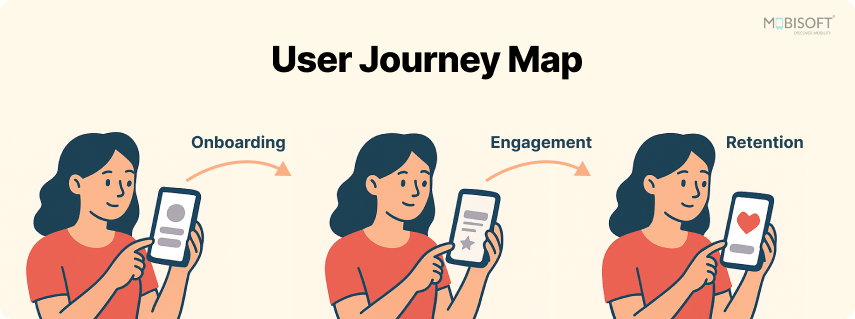
Mobile development is moving at record speed. Super apps, AI-driven personalization, and 5G-enabled collaboration are raising the bar for how users engage. Tools like AI, augmented reality, actionable data, and secure cloud connections now give businesses the edge to boost productivity and serve customers better in experience-led product development.
AI as a Business Partner
AI goes beyond just automation. It acts as a real partner in decision-making. Apps now use AI for things like smart recommendations, resource allocation, bulk checking of data, and personalization. Rather than replacing people, AI supports teams, helping them spot trends, find issues, and fine-tune processes on the fly, improving UX design.
AR for Enterprise Use Cases
Augmented reality isn’t just for consumers anymore; it has now become a practical tool. Companies use AR for product demos during sales, interactive training, and live support.
Discover how DesignOps in UX development can streamline collaboration and make your workflows more efficient.
Why is AR becoming essential for training and support?
For instance, manufacturing teams working remotely can overlay equipment info to troubleshoot on the spot. Retail buyers might preview store layouts before making purchasing decisions.
A recent report from ImmersiveLearningNews shows that DHL, using AR smart glasses for “vision picking,” achieved a 15% boost in productivity and reduced error rates to just 0.1%. This shows education and energy sectors also use AR to visualize complex setups and even handle compliance checks via interactive audits.
Inclusivity and Accessibility: Mandatory for Modern Apps
Designing with experience means making apps work for everyone. Accessibility is front and center. Apps now often include voice controls, customizable layouts, and high-contrast modes to serve diverse users. Over 60% of the apps launched in 2025 had advanced accessibility features from day one, a big jump from 34% in 2023.
Taking this approach improves employee satisfaction and widens the talent pool. It also helps meet compliance needs like ADA and GDPR. Examples range from banking apps supporting screen readers to project management tools. These work by voice for hands-free use, aligning with best UX practices for mobile apps.
Security and Data Privacy: The Experience Multiplier
Security and compliance sit at the heart of the overall experience-led development. With 5G and cloud use rising, platforms need airtight encryption, multi-factor checks, and detailed permission controls.
Why is seamless security critical for user trust?
Seamless security is vital because users won’t adopt apps that feel risky or slow them down. Sensitive data is everywhere, so protection must be strong yet invisible. Tools like Zero Trust, biometrics, and encryption keep data safe without adding friction. If security creates delays, users bypass controls, hurting both adoption and compliance. When it works quietly in the background, security builds confidence and lasting trust.
- A research report by Grand View Research shows that the global Zero Trust security market is projected to grow from USD 36.96 billion in 2024 to USD 92.42 billion by 2030, reflecting a 16.6% CAGR from 2025 to 2030.
Source: Zero Trust Security Market Size, Share & Trends Analysis Report
- The United States has become the global epicenter of ransomware attacks, accounting for 50% of all such incidents worldwide. Depicting a 146% year-over-year increase in attacks, says TechRadar.
Source: US becomes the ransomware capital of the world
- Companies using behavioral data validation and timed access tokens report fewer slip-ups and a stronger mobile app user experience.
2025 Statistics Snapshot
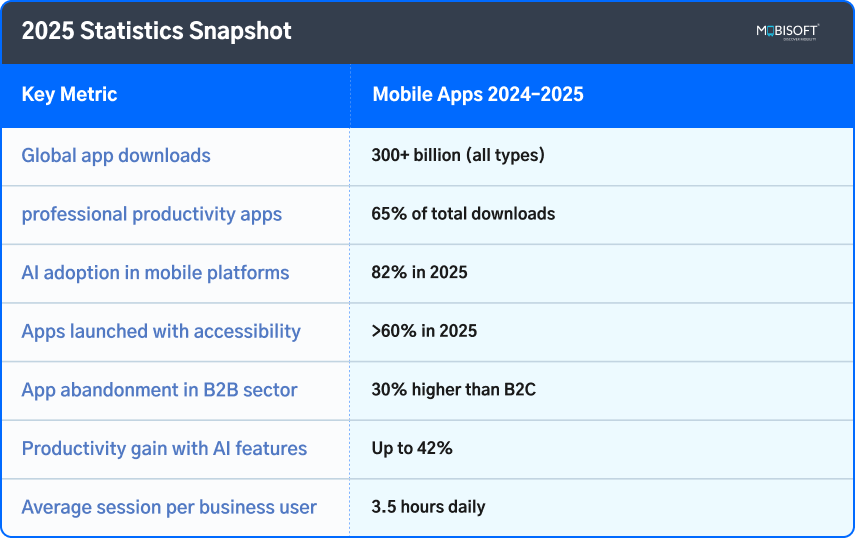
You now have a clear, data-backed understanding of mobile app trends, enriched with practical examples. All the added insights are integrated right where they should be in the heart of the discussion, keeping the focus sharp and professional, aligned with business priorities.
Designing the Future of Mobile Applications
Winning in mobile today means more than having strong technology. It requires blending that with a genuine focus on how users experience the product. Experience-led development turns the old approach around. Instead of starting with a list of features, it begins with clear business goals. This mindset pushes product teams to fully adopt the user’s perspective, mixing real empathy with smart innovation.
Leaders who embrace this approach do more than meet expectations. They anticipate future needs, build authentic trust, and create solutions that drive measurable growth and profitability. The future belongs to platforms that connect businesses and people in meaningful ways. For consumers, experience-led product development provides a clear roadmap for designing the next generation of mobile solutions that truly matter.
Key Takeaways:
- Experience Drives Adoption: mobile apps succeed when they focus on real workflows, reducing friction and boosting engagement.
- Beyond Visuals: True experience-led development prioritizes seamless interaction, efficiency, and actionable insights over flashy features.
- Workflow-Centric Gains: Apps designed around user workflows cut process times, reduce support tickets, and accelerate onboarding.
- Cross-Functional Collaboration: Involving stakeholders from the start ensures apps meet operational, security, and user needs.
- Security Matters: Seamless, frictionless security (Zero Trust, biometrics, encryption) builds trust without slowing adoption.
- Automation & AI Boost Productivity: Intelligent automation and AI reduce errors, save time, and support smarter decision-making.
- AR and Accessibility Expand Value: Augmented reality and inclusive design enhance training, support, and usability for diverse teams.
- Device & Performance Optimization: Mobile apps must be lightweight, fast, and optimized for device constraints to prevent abandonment.
- Data-Driven Decisions: Real-time analytics and dashboards enable actionable insights, fostering efficiency and strategic advantage.
- Long-Term Loyalty: Platforms that save time, simplify tasks, and deliver consistent results cultivate lifetime customers and advocates.


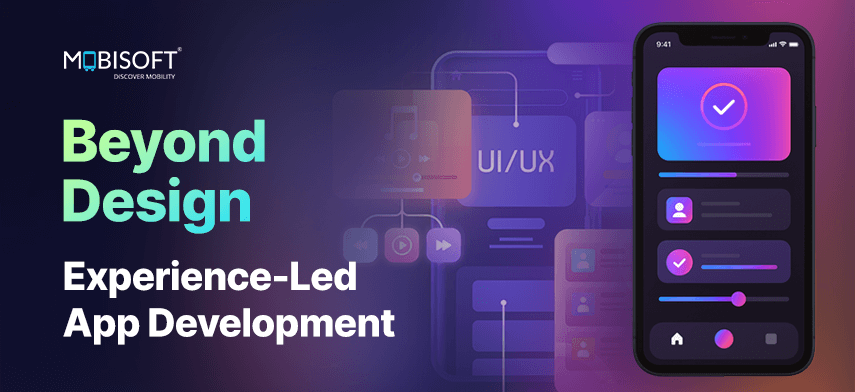


 August 11, 2025
August 11, 2025


